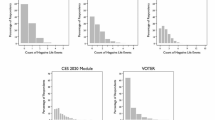Abstract
Incarceration rates in many countries (the US and Australia among them) have risen spectacularly over the last twenty years and are only partially explicable by increases in crime rates. Moreover, in some countries where crime rates have shown a comparable time-path, incarceration rates have not shown the same spectacular increase. The aim of this paper is to explore the politics of punishment. The claim is that the US and Australian experiences are best understood in terms of political considerations; and that this fact lends some support to the “expressive” as distinct from the “interest” approach to electoral behaviour.
Similar content being viewed by others
Notes
It would of course be possible to attack the homo economicus account of human motivation across the board. Then one would deny the assumption of narrow self-interest in both market and electoral settings. But this issue is a largely independent one: the logic of expressive voting theory is that one ought to expect that market and electoral behaviour will be different, whether market behaviour is well characterised by egoistic motives or not.
In the way specifically that orthodox public choice has tended to see them.
Especially in small number settings like the jury or the academic committee.
Suppose for example that a term in prison involves a non-negligible chance of being the victim of rape or violence, or tuberculosis or equivalent disease. Suppose that each year in prison diminishes life expectancy by 10%, even after allowing for other factors. Suppose a period in prison diminishes one’s chance of being employed after release by 40%. It is difficult to see in such circumstances how a period in prison could be effectively related to severity of crime in any reasonably systematic way. (I am not offering these possibilities as established facts. They are claims that are in circulation, and I offer them as claims which invite further, more detailed investigation.)
The violent crime rate rose throughout the period to 1990 (by about 80%) and then fell from its maximum in 1991 to 70% of its 1991 value by 1998.
References
Australian Bureau of Statistics. (1994–1999). Prisoners in Australia. Catalogue No. 4517.0. Canberra: Commonwealth Government Printer.
Australian Institute of Criminology. (1984–1994). Australian prisoners. Canberra: Australian Institute of Criminology.
Australian Bureau of Statistics. (1985). Australian national classification of offences, 1985. Catalogue No. 1234.0. Canberra: Commonwealth Government Printer.
Australian Bureau of Statistics. (2000). Recorded crime. Catalogue No. 4510.0. Commonwealth.
Brennan, G., & Hamlin, A. (1998). Expressive voting and electoral equilibrium. Public Choice, 95, 149–175. doi:10.1023/A:1004936203144.
Brennan, G., & Hamlin, A. (2000). Democratic devices and desires. Cambridge: Cambridge University Press.
Brennan, G., & Lomasky, L. (1993). Democracy and decision. Cambridge: Cambridge University Press.
Brennan, G., & Pettit, P. (1990). Unveiling the vote. British Journal of Political Science, 20, 311–333.
Brennan, G., & Pettit, P. (2004). The economy of esteem. Oxford: Oxford University Press.
Castellano, T., & McGarell, E. (1991). Politics of law and order: Case study evidence for a conflict model of the criminal law formation process. Journal of Research Crime and Delinquency, 28, 304–329. doi:10.1177/0022427891028003004.
Freiberg, A., & Ross, S. (1999). Sentencing reform and penal change. Leichardt: The Federation Press.
Gainsborough, J., & Mauer, M. (2000). Diminishing returns: Crime and incarceration in the 1990's. Washington: The Sentencing Project.
Hough, M., & Roberts, J. V. (1999). Sentencing trends in Britain. Punishment and Society, 1(1), 11. doi:10.1177/14624749922227685.
Rex, S., & Tonry, M. (Eds.). (2002). Reform and punishment: The future of sentencing. Devon: Willan Publishing.
Author information
Authors and Affiliations
Corresponding author
Rights and permissions
About this article
Cite this article
Brennan, G. Crime and punishment: an expressive voting view. Eur J Law Econ 26, 237–252 (2008). https://doi.org/10.1007/s10657-008-9068-4
Published:
Issue Date:
DOI: https://doi.org/10.1007/s10657-008-9068-4




